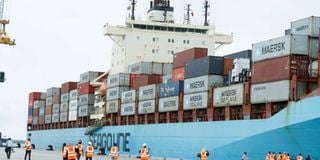Kenya in fresh bid to boost Lamu port status

Lamu Port receives Cargo Ship MV Seago Peraus on August 21, 2021.
What you need to know:
- State scouting for a consultant to conduct an in-depth demand and comparative analysis to maximise the use of the port.
- The port and the targeted special economic zone are part of the Lapsset Corridor project.
- There will be interregional Standard Gauge Railway lines from Lamu to Isiolo, Isiolo to Juba, Isiolo to Addis Ababa, and Nairobi to Isiolo.
Kenya has advanced its plans for a special economic zone (SEZ) around the Lamu port, rolling out a study to map out a strategy for maximising demand for its services and economic catchment.
In a disclosure, the state said it was already scouting for a consultant to conduct an in-depth demand and comparative analysis to maximise the use of the port and its SEZ.
The port and the targeted SEZ are part of the Lamu Port South Sudan Ethiopia Transport (Lapsset) Corridor project.
“The specific objectives of the assignment are to identify and analyse the current demand for the port and SEZ and identify and analyse the seaports currently serving major cities within the area of influence of the Lapsset corridor,” the Lapsset Corridor Development Authority (LCDA) said in a call for a consultant.
Lapsset is Eastern Africa’s largest and most ambitious infrastructure project, bringing together Kenya, Ethiopia, and South Sudan.
It consists of seven key components: a new 32-berth port at Lamu (Kenya); interregional highways from Lamu to Isiolo, Isiolo to Juba (South Sudan), Isiolo to Addis Ababa (Ethiopia), and Lamu to Garsen (Kenya); and a crude oil pipeline from Lamu to Isiolo, Isiolo to Juba and Product Oil Pipeline from Lamu to Isiolo, Isiolo to Addis Ababa.
23 berths
There will be interregional Standard Gauge Railway lines from Lamu to Isiolo, Isiolo to Juba, Isiolo to Addis Ababa, and Nairobi to Isiolo.
Construction of the $5 billion (Sh600.5 billion) Lamu port, with planned 23 deep sea berths, is currently underway.
So far, berths 1, 2, and 3 are complete, with the first berth already operational. The second and third berths are expected to be in use by the year-end.
LCDA requires at least Sh143 billion to set up the Lamu, Isiolo, and Lake Turkana resort cities, which are among the seven key infrastructure components of the Lapsset corridor project.
A report by the agency shows that Lamu resort city will be the largest, costing Sh114 billion, followed by Isiolo city at Sh24 billion. Lake Turkana resort city will cost about Sh5 billion.
In Lamu, the resort city will incorporate an SEZ that will host heavy, light, and medium industries. The SEZ, to sit on 2,000 acres, will also provide warehousing, transport logistics, shipbuilding technology, and a refinery among others.
The Lamu Port was launched last year following delays linked to funding shortfalls to kick-start operations of all three berths.
The first berth was launched last year without completing the installation of equipment, prompting the authorities to borrow kits, including cranes, trailers, gantries, oil spill response, and marine equipment, from Mombasa.
The port can accommodate big container ships owing to its depth, and save time and logistics of getting to Oman’s Salalah Port.
Salalah is the biggest port in the Arabian Peninsula and most ships in Eastern Africa use it for most trans-shipment, potentially putting it in direct competition with Lamu.
Kenya last month said it plans to use the Lamu port in exporting livestock to the Middle East by next year as the country seeks to extend its reach to the world market.
Livestock PS Harry Kimtai said the government had set aside Sh500 million for the construction of a livestock facility at the Lamu port.
The PS said Kenya has signed various sanitary protocols with the Middle East countries to facilitate the export of livestock products.




